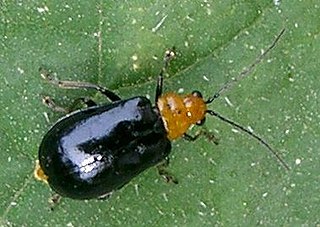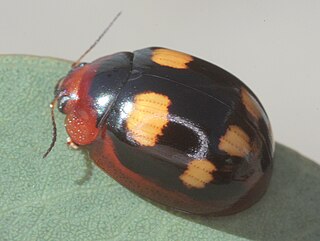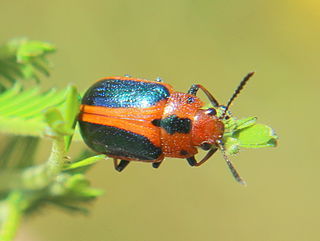
The Chrysomelinae are a subfamily of leaf beetles (Chrysomelidae), commonly known as broad-bodied leaf beetles or broad-shouldered leaf beetles. It includes some 3,000 species around the world.

Chrysolina is a large genus of leaf beetles in the subfamily Chrysomelinae. Most species are distributed in Europe, Asia and Africa with a small number of species inhabiting North America and introduced species in Australia.

Paropsis is a genus of Chrysomelidae, commonly referred to as tortoise beetles, which includes over 70 described species. Their small size, bright colours and patterns, and roughly hemispherical shape cause them to be mistaken for beetles in the family Coccinellidae (ladybirds). They are distributed across Australia, New Zealand and Papua New Guinea. They primarily feed on Eucalyptus but there are a few that feed on Baeckea, Kunzea and Leptospermum. Species within this genus are noted as pests. For example, Paropsis charybdis is a pest of Eucalyptus in New Zealand.

Aulacophora is a genus of beetles in the family Chrysomelidae, commonly known as pumpkin beetles; some species are pests of agricultural crops. The genus was named in 1836 by the French entomologist Louis Alexandre Auguste Chevrolat, in Dejean's Catalogue des Coléoptères. The name, from Ancient Greek, signifies "furrow-bearer"' from aulax, "furrow".

Paropsisterna is a genus of leaf beetles indigenous to Papua New Guinea and Australia. There are over 120 species, many with bright aposematic colours, and many feeding on Eucalyptus leaves.

Dicranosterna is a genus of leaf beetles, in the subfamily Chrysomelinae.

Calomela is a genus of beetles commonly called leaf beetles and in the family Chrysomelidae. They are specialist feeders on various species of Acacia and are not reported as a problem species. The beetles are cylindrical when compared with other leaf beetles and their larvae are globose. Calomela includes about 45 species which are found in all states of Australia.

Chalcolampra is a genus of leaf beetles. These beetles are widespread from Southeast Asia to Australia and New Zealand, but most common in the southeast of Australia. There are approximately 25 Australian species within this genus. There are also 13 species described from New Zealand, with up to an additional 20 undescribed species from the South Island.

The Spilopyrinae are a small subfamily of the leaf beetles, or Chrysomelidae. They occur in Australia, New Guinea, New Caledonia and Chile. They were formerly considered a tribe of the subfamily Eumolpinae. The group was elevated to subfamily rank by C. A. M. Reid in 2000. However, some authors have criticised this placement, preferring to retain them within the Eumolpinae.

Callidemum is a genus of leaf beetles in the subfamily Chrysomelinae.

Calligrapha is a genus of large American Chrysomelinae of imprecise taxonomic boundaries. Most species occur in Central and South America.

Macrocoma is a genus of leaf beetles in the subfamily Eumolpinae. It contains about 100 species, which are found in tropical Africa, around the Mediterranean, on the Canary Islands, in western and central Asia, and in India.

Eumolpini is a tribe of leaf beetles in the subfamily Eumolpinae. It is the largest tribe in the subfamily, with approximately 170 genera found worldwide. Members of the tribe almost always have a longitudinal median groove on the pygidium, which possibly helps to keep the elytra locked at rest. They also generally have a subglabrous body, as well as appendiculate pretarsal claws.
Eboo is a genus of leaf beetles in the subfamily Eumolpinae. It is endemic to Australia, and contains approximately 50 species. Many of these species show strong sexual dimorphism, and they feed primarily on Eucalyptus plants.
Edusella is a genus of leaf beetles in the subfamily Eumolpinae. They mainly occur in Australia, with a single species occurring in New Caledonia.

Lamprolina is an Australian genus of leaf beetles (Chrysomelidae) found in Victoria, New South Wales, and Queensland.
Phola is a genus of leaf beetles in the family Chrysomelidae, subfamily Chrysomelinae. It occurs in east and south-east Asia, the south-west pacific, eastern and northern Australia. It was formerly a synonym of Chalcolampra. It is distinguished from other chrysomeline genera in Australia by the twisted epipleura, but its recognition may render either Chalcolampra or Phyllocharis paraphyletic.















